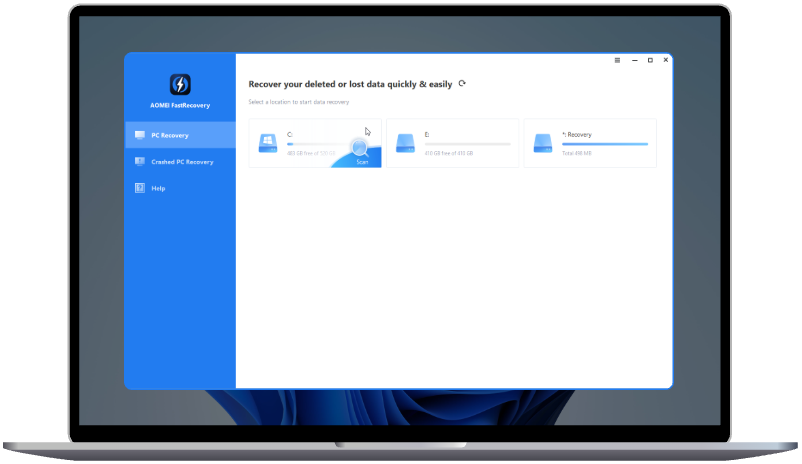How to Clone 500GB HDD to 256GB SSD without Data Loss
Learn how to clone 500 GB HDD to 256/120 GB SSD without data loss in Windows 11, 10, 8, 7.
Need to clone 500 GB HDD to 256 GB SSD
“To have better experience in booting the operating system or loading programs, I have purchased a 256 GB Toshiba Q Series Solid State Drive and I have a 500 GB HDD with only 129 GB used. Now, I want to replace my HDD with the SSD.
But I’m really unwilling to make a fresh installation of Windows and other applications on SSD. Thus, I want to clone the old HDD to the new Toshiba SSD. I know that it is available to clone HDD to smaller SSD. But what should I do?
Great cloning software: Clone HDD to SSD easily and safely
It is common to choose to purchase an SSD whose capacity is smaller than HDD's due to SSD’s price. You can easily clone 500 GB HDD to 256/120 GB SSD as long as the used space of your source hard drive is not beyond the capacity of the target SSD with drive cloning software, like AOMEI Partition Assistant Professional.
► It can clone only used space of source disk, enabling you to clone larger hard drive to smaller drive, covering 500 GB HDD to 120/256 GB SSD, 2 TB HDD to 500 GB SSD etc. without data loss.
► And it can make SSD partition alignment to improve SSD’s performance while copying HDD to SSD.
► It works under Windows 11, 10, 8, 7. To clone HDD to SSD in Windows Server 2025/2022/2019/2016/2012/2008, please use AOMEI Partition Assistant Server.
You need to connect the SSD to your PC and make sure that it can be detected by your OS. If what you own is a laptop, you might need a USB-to-SATA cable.
✍ Note: You can free download the demo version of AOMEI Partition Assistant Professional to stimulate the operation and preview the operation result.
How to clone 500 GB HDD to 256 GB SSD
Step 1. Install and launch AOMEI Partition Assistant, click "Clone" in the main interface and select "Clone Disk".
Step 2. Choose the hard disk that you need to clone as the source disk and click "Next".
Step 3. Select the destination disk to store the data on the source disk, and then click "Next".
Step 4. Then, you can check the source and destination disk in the next window or change to “Sector to Sector clone”, and click the "Confirm" button to continue if there is no problem.
Here, you can also click the "Settings" button to adjust the partition size on the destination disk or tick "4k alignment" to improve the reading and writing speed of SSD if the target disk is an SSD drive.
Step 5. At last, click "Apply" and "Proceed" in the main interface to start cloning the hard drive.
Notes:
▪ If you want to keep your 500 GB HDD as your data storage simultaneously, to boot OS from the new cloned 256 GB SSD, you need to enter BIOS to change the boot order.
▪ If you clone HDD to a larger disk, you might get unallocated space after cloning, you can add unallocated space to another partition to make full use of it.
A faster way to upgrade HDD to SSD without reinstalling
With the help of AOMEI Partition Assistant Professional, provided that the used space of HDD is not beyond the size of SSD, you can easily transfer all the data on HDD to smaller SSD without reinstalling Windows. But what if the used space is larger than the capacity of the SSD?
If you don’t care about other applications, turn to AOMEI Partition Assistant Professional, and it can tackle this situation via moving HDD OS-related partitions to smaller SSD. In this way, you can upgrade HDD to SSD without Windows reinstallation. The detailed steps to migrate OS from 500 GB HDD to a smaller 256 SSD are as follows:
Step 1. Run AOMEI Partition Assistant Professional and select "Migrate OS to SSD" and "Next".
Step 2. Choose disk space on the SSD and click "Next".
Step 3. Adjust the system partition on SSD as you like.
Keep the Note about how to boot from the destination disk in mind. Then, click “Finish”.
Step 4. Click “Apply” to perform the operation.
Bottom Line
When you need to clone 500 GB HDD to 256 GB SSD, you can try AOMEI Partition Assistant Professional. To get to know more features of it, you can refer to help guides.
